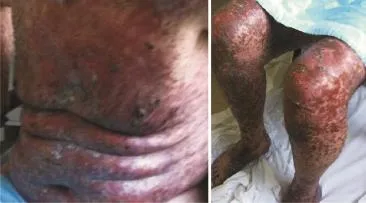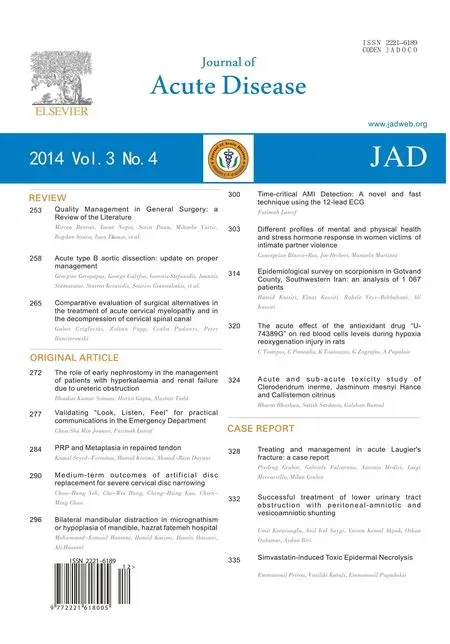Simvastatin-induced Toxic Epidermal Necrolysis
Emmanouil Petrou, Vasiliki Karali, Emmanouil Papadakis
1Onassis Cardiac Surgery Center, Athens, Greece
2First Department of Propaedeutic and Internal Medicine, Athens University Medical School, Athens, Greece
Simvastatin-induced Toxic Epidermal Necrolysis
Emmanouil Petrou1, Vasiliki Karali2, Emmanouil Papadakis1
1Onassis Cardiac Surgery Center, Athens, Greece
2First Department of Propaedeutic and Internal Medicine, Athens University Medical School, Athens, Greece
Toxic epidermal necrolysis comprises a severe immune-complex mediated hypersensitivity reaction that typically involves the skin and mucous membranes. Herein, we describe a 68-year -old man who presented with the condition after simvastatin administration.
ARTICLE INFO
Article history:
Received 12 Jan 2015
Received in revised form 13 Jan 2015
Accepted 15 Jan 2015
Available online 17 Jan 2015
Toxic epidermal necrolysis
1. Introduction
Stevens-Johnson syndrome (SJS) and toxic epidermal necrolysis (TEN) are severe immune complex mediated hypersensitivity reactions that typically involve the skin and mucous membranes. The incidence of SJS is approximately 6 cases per million persons per year, and incidence of TEN is approximately 2 cases per million persons per year[1].
2. Case report
A 68-year-old man was admitted to our hospital for a scheduled coronary artery bypass grafting operation due to three-vessel coronary artery disease. The treatment scheme before the operation included aspirin, atenolol, ramipril and atorvastatin. In the post-operative therapeutic scheme, 10 mg of atorvastatin daily was replaced with 20 mg of simvastatin daily. On the second post-operative day, the patient complained malaise and arthralgia. A macular rash was covered the thorax and lower extremities also started to appear, and within hours necrotic lesions covering the entire body surface were formed (Figure 1). Histopathologic examination of the skin revealed dermal inflammatory infiltration and full-thickness necrosis of the epidermis. The former, combined with keratinocytes apoptosis and specific CD+ T lymphocytes dermal stratification patterns were diagnostic for TEN. Simvastatin was removed and the patient fully recovered within four weeks.
3. Discussion
SJS was first described in the 1920’s, as an acute mucocutaneous syndrome. French LE described four patients with an eruption resembling scalding of the skin which he called TEN[2]. Genetic predisposition and a strong association between human leukocyte antigen, drug hypersensitivity and ethnic backgroundare believed to be associated with the syndrome’s appearance[3].

Figure 1. Necrotic lesions covering the thorax and lower extremities.
Typical prodromal symptoms of SJS/TEN include headache, malaise, arthralgia and productive cough with thick, purulent sputum. Patients may complain of a burning rash that begins symmetrically on the face and the upper part of the torso. Signs of mucosal involvement may include erythema, edema, sloughing, blistering, ulceration or necrosis, as in our patient. Finally, ocular involvement can be present including the cornea, the eyelids and conjunctiva[4].
Dermal inflammatory cell infiltrate and full-thickness necrosis of the epidermis are typical histopathologic findings in patients with SJS/TEN. Histopathologic examination of the skin can also reveal the following: changes in the epidermal-dermal junction ranging from vacuolar alteration to subepidermal blisters, perivascular dermal infiltrate, keratinocytes apoptosis and specific CD+ T lymphocytes dermal stratification patterns. Additionally, conjunctival biopsies from patients with active ocular disease reveal subepithelial plasma cells and lymphocyte infiltration[5]. The differential diagnosis of SJS/TEN includes autoimmune blistering diseases, including linear immunoglobulin A dermatosis and paraneoplastic pemphigus, but also pemphigus vulgaris and bullous pemphigoid, acute generalized exanthematous pustulosis, disseminated fixed bullous drug eruption and staphylococcal scalded skin syndrome[6].
Management of SJS/TEN requires early diagnosis, immediate discontinuation of the causative drug(s), and supportive care. Some authors have advocated the use of corticosteroids, cyclophosphamide, plasmapheresis, hemodialysis, TNF antagonists and immunoglobulin; however these treatments remain controversial[7].
The statin medications for lowering of blood cholesterol have been reported to associate with “chameleon-like”cutaneous eruptions but also a variety of other adverse cutaneous eruptions, including SJS/TEN, porphyria cutanea tarda, linear immunoglobulin A bullous dermatosis, and lupus and dermatomyositis-like pustular reaction patterns[8].
According to adverse drug reaction probability scale proposed by Naranjoet al., the described condition is designated as a probable reaction to simvastatin[9]. However, we claim that in the absence of an alternative cause that could have elicited the reaction. A high level of suspicion for an unexplained necrotic cutaneous eruption in an individual on statins is important to identification of the disorder and discontinuation of the offending medication.
Conflict of interest statement
The authors report no conflict of interest.
[1] Roujeau JC, Stern RS. Severe adverse cutaneous reactions to drugs. N Engl J Med 1994; 331: 1272-1285.
[2] French LE. Toxic epidermal necrolysis and Stevens Johnson syndrome: our current understanding. Allergol Int 2006; 55: 9-16.
[3] Chung WH, Hung SI, Hong HS, Hsih MS, Yang LC, Ho HC, et al. Medical genetics: a marker for Stevens-Johnson syndrome. Nature 2004; 428: 486.
[4] Hamm RL. Drug-hypersensitivity syndrome: diagnosis and treatment. J Am Coll Clin Wound Spec 2011; 3: 77-81.
[5] Wei CY, Ko TM, Shen CY, Chen YT. A recent update of pharmacogenomics in drug-induced severe skin reactions. Drug Metab Pharmacokinet 2012; 27: 132-141.
[6] Harr T, French LE. Stevens-Johnson syndrome and toxic epidermal necrolysis. Chem Immunol Allergy 2012; 97: 149-166.
[7] Worswick S, Cotliar J. Stevens-Johnson syndrome and toxic epidermal necrolysis: a review of treatment options. Dermatol Ther 2011; 24: 207-218.
[8] Adams AE, Bobrove AM, Gilliam AC. Statins and“chameleon-like” cutaneous eruptions: simvastatininduced acral cutaneous vesiculobullous and pustular eruption in a 70-year-old man. J Cutan Med Surg 2010; 14: 207-211.
[9] Naranjo CA, Busto U, Sellers EM, Sandor P, Ruiz I, Roberts EA, et al. A method for estimating the probability of adverse drug reactions. Clin Pharmacol Ther 1981; 30: 239-245.
ment heading
10.1016/S2221-6189(14)60072-X
*Corresponding author: Emmanouil Petrou, 29 Kioutacheias street, GR-142 31 Nea Ionia, Greece.
Tel: +306945112509
Fax: +302102751028
E-mail: emmgpetrou@hotmail.com
Simvastatin
 Journal of Acute Disease2014年4期
Journal of Acute Disease2014年4期
- Journal of Acute Disease的其它文章
- Successful treatment of lower urinary tract obstruction with peritonealamniotic and vesicoamniotic shunting
- Treating and management in acute Laugier's fracture: a case report
- Acute and sub-acute toxicity study of Clerodendrum inerme, Jasminum mesnyi Hance and Callistemon citrinus
- The acute effect of the antioxidant drug “U-74389G” on red blood cells levels during hypoxia reoxygenation injury in rats
- Epidemiological survey on scorpionism in Gotvand County, Southwestern Iran: an analysis of 1 067 patients
- Time-critical AMI Detection: A novel and fast technique using the 12-lead ECG
